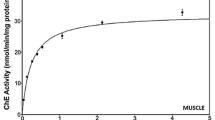Abstract
The substrate specificity of brain acetylcholinesterase (AChE) in adult Carassius auratus fish and its sensitivity to carbamate insecticides were investigated in vitro. The results showed that the order of four substrates hydrolyzed by brain AChE in C. auratus was acetylthiocholine iodide > β-methylthiocholine iodide > propionylthiocholine iodide > butyrylthiocholine iodide, and the maximum velocity (V max) of AChE hydrolyzing acetylthiocholine iodide (ATCh) was the highest among the four substrates, and the V max values were 0.067 and 0.082 mmol min−1 mg−1 for male and female fish respectively. But their Michaelis–Menten constants (K m) were the lowest, only 0.071 and 0.072 mmol/l respectively. Compared with other carbamate insecticides, the sensitivity of brain AChE to carbofuran was the highest and the IC50 values were 1.04 × 10−6 mol/l for females and 1.17 × 10−6 mol/l for males. The inhibitory tendencies of eserine, methomyl, and aldicarb to brain AChE were very similar, and the percentage inhibition increased with time at the concentration of 1 × 10−6 mol/l. The order of inhibition potential of the three inhibitors from the highest to the lowest was eserine, aldicarb, and methomyl.


Similar content being viewed by others
Abbreviations
- AChE:
-
Acetylcholinesterase
- ATCh:
-
Acetylthiocholine iodide
- BuTCh:
-
Butyrylthiocholine iodide
- β-MTCh:
-
β-methylthiocholine iodide
- PrTCh:
-
Propionylthiocholine iodide
- BSA:
-
Bovine serum albumin
- DTNB:
-
5, 5′-dithio-bis (2-nitrobenzoic acid)
References
Bradford MM (1976) A rapid and sensitive method for the quantification of microgram quantities of protein using the principle of protein–dye binding. Anal Biochem 72:248–254
Carr RL, Chambers JE (1996) Kinetic analysis of the in vitro inhibition, aging, and reactivation of brain acetylcholinesterase from rat and channel catfish by paraoxon and chlorpyriphos-oxon. Toxicol Appl Pharmacol 139:365–373
Chuiko GM (2000) Comparative study of acetylcholinesterase and butyrylcholinesterase in brain and serum of several freshwater fish: specific activities and in vitro inhibition by DDVP, an organophosphorus pesticide. Comp Biochem Physiol 127(C):233–242
Chuiko GM, Podgornaya VA, Zhelnin YY (2003) Acetylcholinesterase and butyrylcholinesterase activities in brain and plasma of freshwater teleosts: cross-species and cross-family differences. Comp Biochem Physiol 135(B):55–61
Duan XS, Yang LY, Ye P (1998) The synthesis of thiodicarb. Agrochemical 37(3):7–8
Eder KJ, Leutenegger CM, Wilson BW, Werner I (2004) Molecular and cellular biomarker responses to pesticide exposure in juvenile Chinook salmon (Oncorhynchus tshawytscha). Mar Environ Res 58:809–813
Ellman GL, Courtney KD, Andres V, Featherstone RM (1961) A new and rapid colorimetric determination of acetylcholinesterase activity. Biochem Pharmacol 7:88–95
Galgani F, Bocquene G (1990) In vitro inhibition of acetylcholinesterase from four marine species by organophosphates and carbamates. Bull Environ Contam Toxicol 45:243–249
Gao XW, Zheng BZ (1996) Substrate specificity and developmental changes of acetylcholinesterase in cotton bollworm. Entomol Sin 3(1):80–89
Gorun V, Proinov I, Baltescu V, Balaban G, Barzu O (1978) Modified Ellman procedure for assay of cholinesterase in crude enzymatic preparations. Anal Biochem 86:324–326
Habig C, Giulio RT (1998) The anticholinesterase effects of the cotton defoliant S,S,S-tri-n-butyl phosphorotrithioate (DEF) on channel catfish. Mar Environ Res 24:193–197
Hassall K (1990) The biochemistry and uses of pesticides. Macmillan, London
Johnson JA, Wallace KB (1987) Species-related differences in the inhibition of brain acetylcholinesterase by paraoxon and malaoxon. Toxicol Appl Pharmacol 88:234–241
Kirby MF, Morris S, Hurst M, Kirby S (2000) The use of cholinesterase activity in flounder (Platichthys flesus) muscle tissue as a biomarker of neuro-toxic contamination in UK estuaries. Mar Pollut Bull 40:780–791
Leatherbarrow RJ (1987) Enzifitter, a non-linear regression data analysis program for the IPM PC (and true compatibles) manual. Elsevier Science Publishers BV, Amsterdam, Netherlands, pp 1–91
Leng XF, Tang ZH, Wang YC (1996) Molecular toxicology of insecticides and insect resistance. China Agriculture Press, Beijing, pp 30–56
Li SN, Fan DF (1996) Correlation between biochemical parameters and susceptibility of freshwater fish to malathion. J Toxicol Environ Health 48:413–418
Monserrat JM, Bianchini A (1998) Main kinetic characteristics of thoracic ganglia cholinesterase of Chasmagnathus granulate (Decapoda, Grapsidae). Comp Biochem Physiol 120(C):193–199
Payne J, Mathieu A, Melvin W, Fancey LL (1996) Acetylcholinesterase, an old biomarker with a new future? Field trials in association with two urban rivers and a paper mill in Newfoundland. Mar Pollut Bull 32:225–231
Silva MV, Oliveira MM, Salles JB, Cunha VLF, Cassano VPF, Cunha J (2004) Methyl-paraoxon comparative inhibition kinetics for acetylcholinesterases from brain of neotropical fishes. Toxicol Lett 153:247–254
Vellom DC, Radic Z, Li Y, Pichering NA, Camp S, Taylor P (1993) Amino acid residues controlling acetylcholinesterase and butyrylcholinesterase specificity. Biochemistry 32:12–17
Zeng XZ, Duan XS, Yang LY (1995) Methods for preparation of carbosulfan. Agrochemical 34:12–13
Acknowledgements
This research was supported by NSFB (contract/grant number: 6062018) and NSFC (contract/grant number: 30170621 and 39970496).
Author information
Authors and Affiliations
Corresponding author
Rights and permissions
About this article
Cite this article
Liu, H., Yi, M., Shi, X. et al. Substrate specificity of brain acetylcholinesterase and its sensitivity to carbamate insecticides in Carassius auratus . Fish Physiol Biochem 33, 29–34 (2007). https://doi.org/10.1007/s10695-006-9114-5
Received:
Accepted:
Published:
Issue Date:
DOI: https://doi.org/10.1007/s10695-006-9114-5




